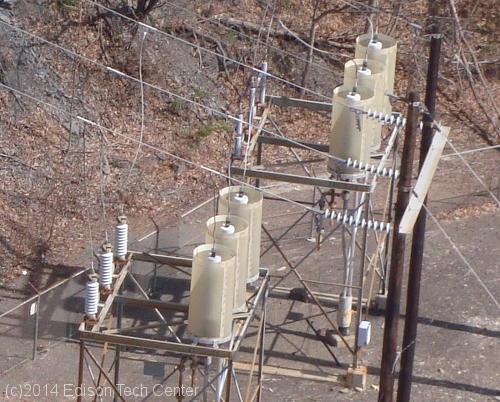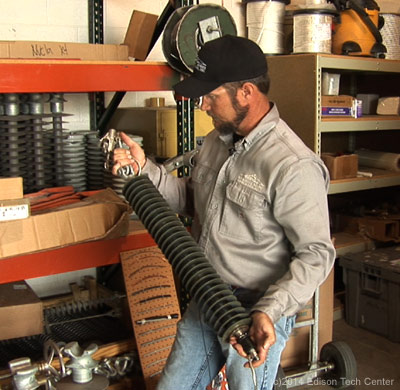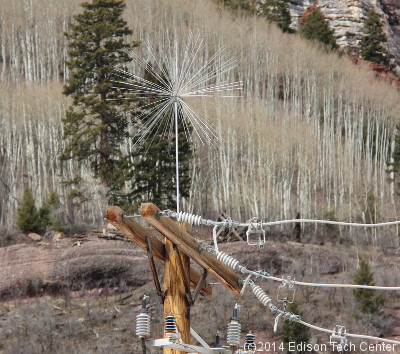Lightning and Fault Suppression
Lightning has the ability to destroy a multi-million dollar transformer or take out millions of tiny devices in homes across the grid. Electrical engineers have spent over 130 years devising ways to control lightning and power surges in the electrical distribution grid. Learn some basics on this page about the interesting devices used to control nature's wildest side.
Insulation is the weak point in a power system and is subject to break down when exposed to extremely high voltages caused by lightning, faults or reenergization of a line. Since the beginning of the electric grid direct lightning strikes and indirect atmospheric effects of it have been a challenge. We use different devices to deal with different problems caused by lightning.
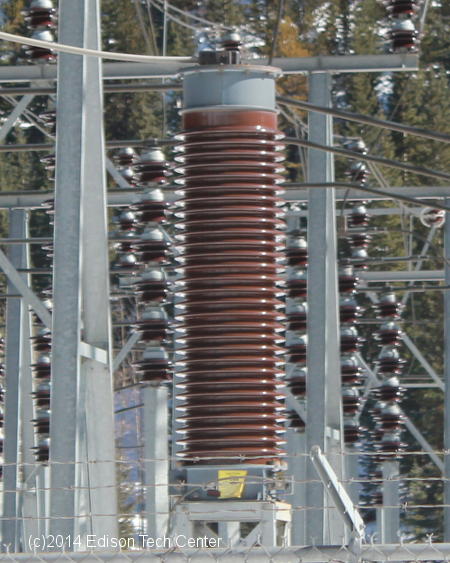 |
|
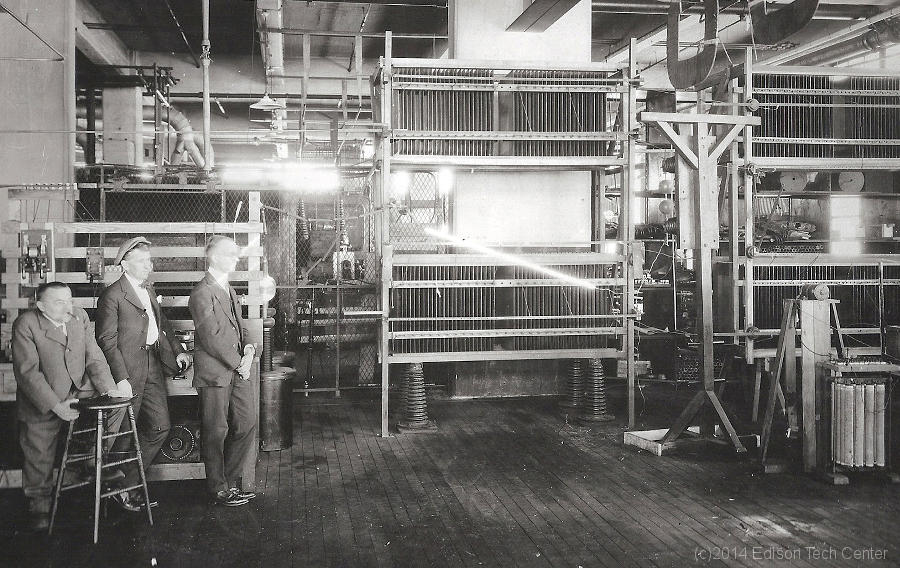
Above: Charles Steinmetz in his lightning lab. He was one of the first to create "artificial lightning" for use in testing utility systems. Later on Pittsfield, MA became one of the most important testing grounds for lightning research in regards to power grid design.
1. About lightning:
In a thunderstorm negatively charged leaders descend from the cloud
looking for the strongest accumulation of ground charge in the area.
The leaders move 50 meters down at a time, then stop and readjust direction
towards ground potential.
As the lightning reaches within 150 meters of the ground streamers reach
upward (+) . The streamer with the strongest charge attracts the leader,
it connects and that is where the lightning strikes. The other streamers
retract and dump their energy back into the object they came from.
All objects on the ground carry (+) charge up and dissipate it into
the atmosphere. Points like the top of a transmission tower or antenna
carry (+) charge up and the sharp points have difficulty dissipating
the charge, so the positive charge just builds up at the tips of metal
ends. This makes this spot likely to for a strong streamer.
|
Learn more detail about lightning
here from NOAA.
|
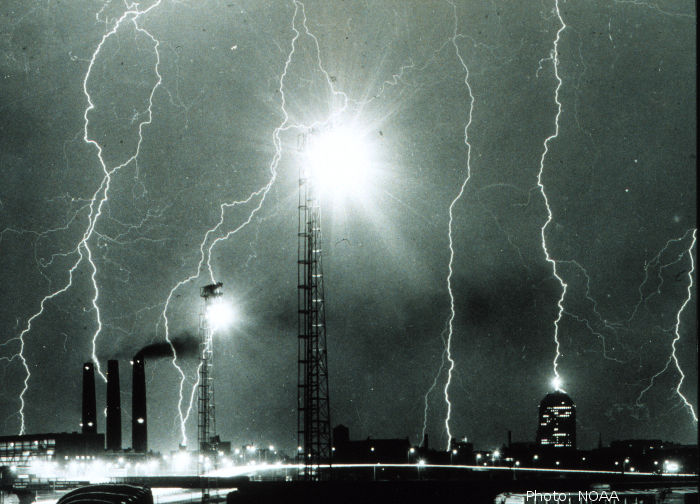
Types of lightning suppression:
Types of surges:
Both lightning surges and power line switching surges are represented during testing as "double exponential" waveforms. This means that a lightning surge rises to its peak value in 1.2 microseconds and decays to one-half of this in 50 microseconds; thus it is called a "1.2 x 50" waveform.
A "switching surge" waveform is much longer; it rises to its peak in roughly 200 microseconds and decays to half value in a few thousand microseconds.
|
2. Fuses
Why aren't fuses enough to stop lightning?
A fuse is a 'simple' type of interrupter. A fuse destroys itself (melts),
severing the electrical connection when it receives sustained current
or voltage above a certain level. The fuse acts as a resistor and generates
heat used to melt the element. The speed at which a fuse melts is very
important as it can let some damaging voltage through if it is not fast
enough. The voltage rating in a fuse is important as a very high voltage
(like from lightning) can arc across the fuse which may have already
been blown. Thus the fuse becomes useless at stopping surges from direct
lightning strikes. Fuses are also very slow compared with Metal Oxide
Varistors and other devices mentioned here. In homes, breakers have
replaced fuses. Learn about breakers lower
down on this page.
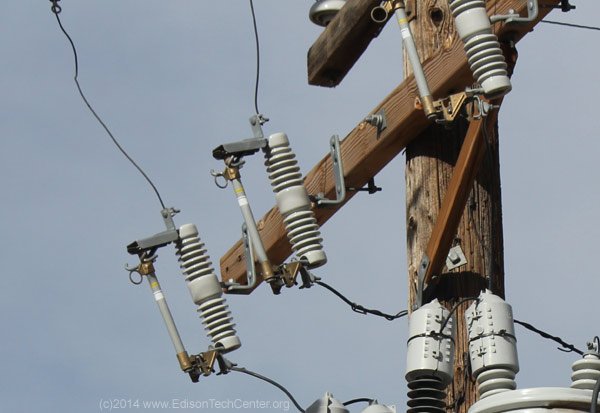
Above: line fuses used on common powerlines. See a video of a fuse blowing here.
Pad-mounted fused switches are used in the power grid. They
are low cost, but are 'dumb' as they cannot provide data about the surge.
Fuses also require a crew to go out to the substation and replace them
after they have blown. This can cause 30 minutes or more of disruption
of power service to the area. See this short video from ABB which shows
how the fuse is replaced.
3. Lightning Arresters
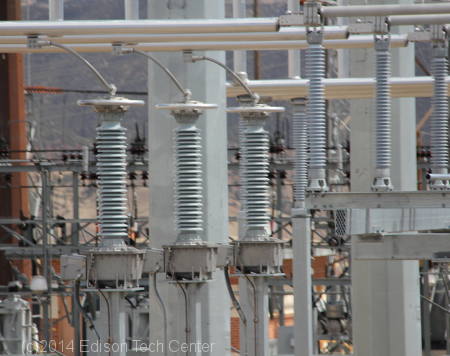
Lightning Arrester - a device on an electric power or telecommunication system which diverts power to ground when the system takes sees an extreme voltage spike. These devices are designed to work with a direct lightning strike, or an extreme surge from an fault somewhere down the line. The lightning arrester is essentially an automatic switch designed to work instantaneously.
Many lightning arresters are needed at each substation as each transformer and piece of switching equipment needs to be protected. There are many kinds of lightning arresters, such as expulsion and valve types. Note that large circuit breakers at the substation and lightning arresters look similar, they are both tall ceramic tubes.
Below Left: lightning arrester on display at Edison Tech Center. Below Right: Arresters at Poughkeepsie, NY
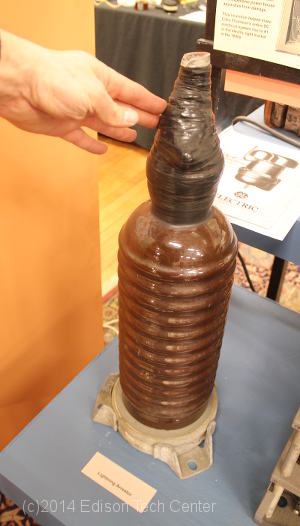 |
|
Station and line-type arresters can be built into units. Units can be stacked in series to create an arrester with a higher rating.
Right: lightning arresters built onto a large substation transformer. Transformers contain coils of wire with thin polymer insulation on each wire. It doesn't take much overvoltage to burn through this insulated wire. Large transformers are extremely expensive to replace and repair. We use voltage regulators and fault protection to precisely control what voltage goes into the transformer.
Left: Line type arresters are attached to power poles periodically and give strikes along the line a path to ground. M. Morlang holds a typical modern line-type lightning arrester rated for 69 kV power lines.
4. Surge Arresters (SPDs)
When lightning strikes close to a powerline it induces a surge in the lines due to the electromagnetic pulse (EMP). EMPs are also called "transient electromagnetic disturbances". Surge arresters are designed to prevent surges caused by a "lightning flash" EMP or other transients from affecting large areas of the grid. They do not protect against a direct strike on your line, this device stops surges which have a slower rise than direct strikes, which have a rapid rise in voltage. Electromagnetic Compatibility Engineers specialize in understanding the phenomena and damage caused by EMPs.
The surge arrester became very important as consumer devices with semiconductors proved to be very sensitive to mild surges. Prior to the 1960s mild surges had always existed in the web but there was not the need to have as precise control of them. Most consumer electronics have some type of Zinc Metal Oxide surge protector. See how they work in our video here.
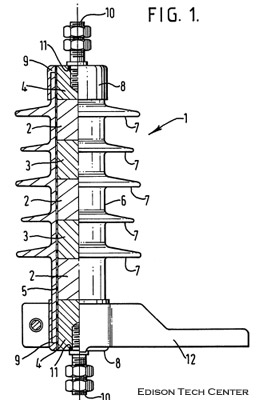 |
|

Above: "station surge arresters"
and large lightning arresters in a substation. Notice the long shield wires
hanging above the substation to catch the direct lightning strikes.
It took over 40 years to develop the ideal gapless surge arrestor. Ohio Brass (Hubbell Incorporated) is now the leading manufacturer of station class surge arrestors. They purchased their patents from the General Electric Pittsfield operation.
5. Air Terminal (Lightning Rod / Shield Wire)
Air Terminal - a piece of metal either vertical (rod) or horizontal
(shield wire) which connects with a lightning bolt and channels the
energy to the ground. It diverts the bolt away from more sensitive items
like powerlines, antennas, or a flammable structure like a wood barn.
Shield wires are visible around substations and radio antennas as long
grounded cables. On regular neighborhood service powerlines you may
see a catenary at the top of the pole on the highest point, and the
three power lines will be on the cross bar just below it.
|
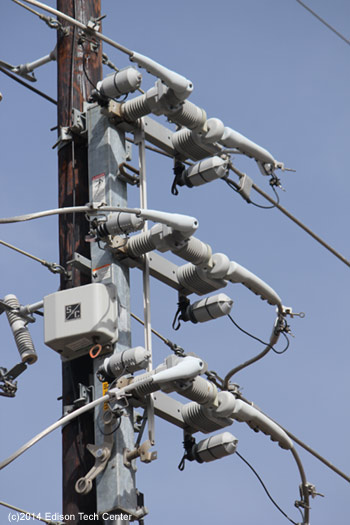 |
8. Interrupters (Breakers)
When a circuit must be disconnected for maintenance you can use a breaker, however high voltage presents a large problem. When you pull two electrodes away from each other an arc will develop. The arc causes ionization of the air and electricity still wants to flow.
Air or Gas Blast Switchgear
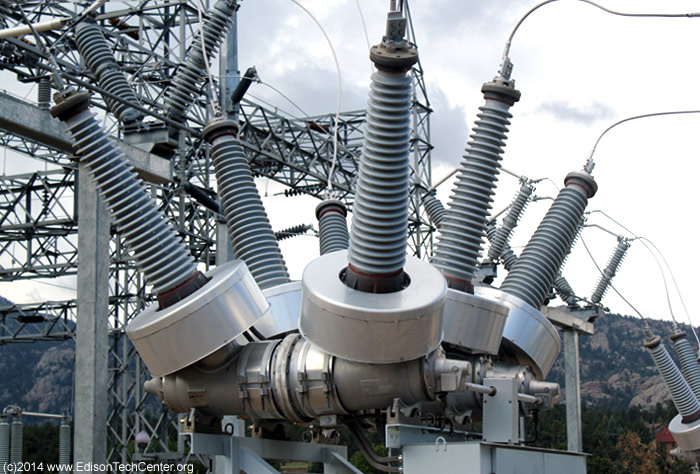
As we move the two conductors apart we use an high pressure air or gas blast to push the arc away and disrupt it. This is basically 'blowing' arc out. In the photo above the strong metal chamber at the base is the pressurized area.
Vacuum Fault Interrupters (VFI)
These breakers can be controlled by microprocessor relays or operated manually by a crew and use a container with a vacuum to prevent and arc from forming.
Pad mounted breakers
This type of digital breaker can be reset remotely by computer. They can be reset quickly in about 10 minutes. These keep a full record of outages and can replace the 'dumb' fuse which gives no such data. This higher cost option is a component of smart grid technology.
|
Learn more detail about breakers
here.
|
9. Reclosers
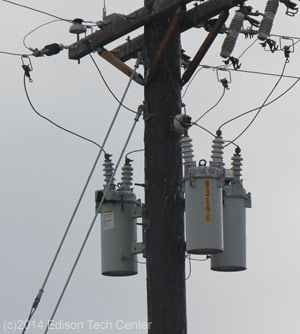 |
|
A curve - short fast curve, when it meets the required amount
of fault current it operates quickly disconnecting the line
C curve - leaves the fault current on the line longer, this would
allow the arc to operate longer, burning off a balloon or small treebranch.
It also leaves power going for long enough to blow fuses down at fuse
taps.
You can put faster OCRs behind electronic devices, which can save expensive smart grid components from damage. The slower curve OCRs are useful when in conjunction with fuses.
10. Arcing Horns
These devices have been around for a long time and help prevent flashovers when lightning or other transient strikes a line. They work by basically having high voltage 'jump' over the horn gap and go to ground instead of putting the full force through sensitive devices. They didn't work very well compared to modern lightning arresters but they are still used in some places as they are low cost.
Flashovers:
Insulators may not be able to take the
high voltages of spikes and arcs will form between the wire and the
towers. Horn gaps used to be a rudimentary protection for transformers
as seen in the photo from the 1910s below.
|
Learn more detail about Flashovers
Here.
|
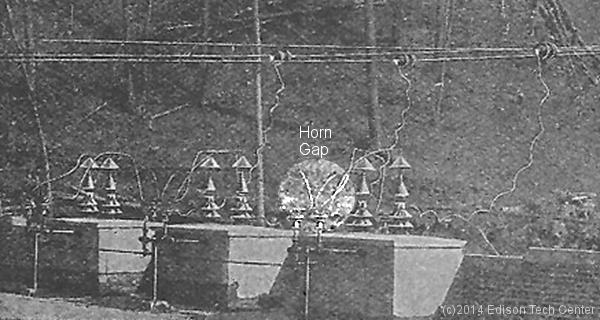
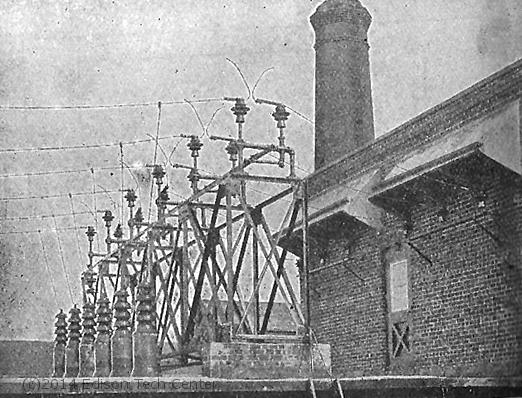
11. Historical Timeline
300 BC - The Anuradhapura Kingdom uses metal strips in Buddhist temples to protect them from lightning strikes |
 Above: a large substation lightning arrester at Gnuella Pass, CO |
1900s - Gapped silicon carbide arresters are the primary arresters found on utility lines
1967 - SiC (Silicon Carbide Varistor) arresters replace gapped silicon carbide arresters
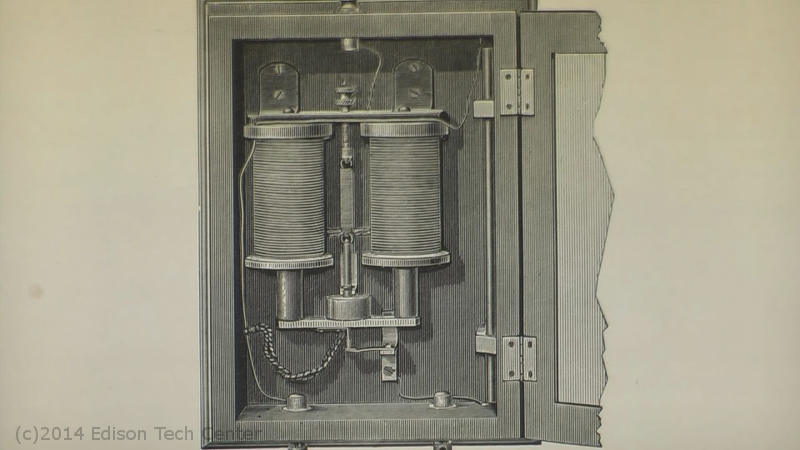
Above: Elihu Thomson's company formed the bulk of General Electric in 1892, however this magnetic lightning arrester above helped differentiate his system from competitors during the intense electric lighting system wars of the 1880s. This uses a magnetic control to open the circuit when a voltage spike is detected. This protected the DC generation system (dynamo and other apparatus) from damage.
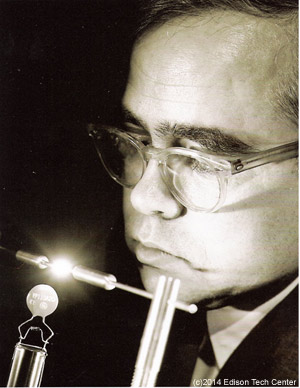 |
|
12. Testing for Lightning
Today engineers model for lightning strikes using sophisticated software,
however at one time companies had the need to simulate lightning at
laboratories. Pittsfield Massachusetts was the primary testing area
for transients in power systems for almost 100 years. They had two 'lightning'
machines which could produce millions of volts. General Electric would
test utility systems using miniature models of a system. Many of these testing facilities
at the High Voltage Lab had elaborate scale models.
Stay tuned for future videos here:
Link: VIDEO - Blalock on lighting testing at Pittsfield, NYC
Link: VIDEO - Bob Ringlee and Barthold at PTI on surge protection
|
Transformers |
Dynamos and Generators |
AC Power History |
Meters and Voltage Regulators |
History of Electrification |
Wires and Cables |
Article by M. Whelan, John Harnden Jr. and Thomas Blalock
Sources:
Alltec Global
Kapikaco
History of Arresters on Power Systems 1930-1965. by Jonathan J. Woodworth.
ArresterWorks
History
of Arresters on Power Systems 1965-Present by Jonathan J. Woodworth.
ArrestorWorks
Overvoltage and Flashovers. myinsulators.com. 1974
ABB
Computer Hope
Isolating a Disconnect Circuit Breaker. ABB Sverige.
Photos:
Edison Tech Center
Whelan Communications
Schenectady Museum Hall of History
US Patent Office
Hawkins Electrical Guide. 1914


